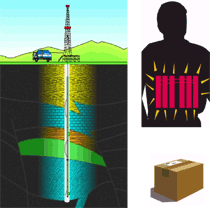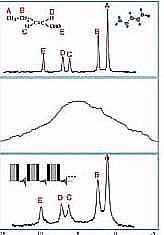
The Berkeley Lab ex situ NMR and MRI technique can be used for oil well logging (left), stand-off detection (top right), and cargo inspection (bottom right).
APPLICATIONS:
- Industrial sensing
- Oil well logging
- Medical imaging for large subjects
- Spectroscopy
- Imaging subjects or objects with ferromagnetic components
- Cargo inspection
- Stand-off detection
ADVANTAGES:
- Samples can be outside of magnet
- Generates high resolution spectra
- Quick and transportable

NMR spectrum of trans-2-pentenal under ordinary high resolution conditions. Peaks corresponding to the five non-equivalent hydrogen nuclei are observed. Spectrum with sample placed in a non-uniform field outside of the rf coil; all chemical information is lost. A specially designed rf pulse train (inset rectangles) nuclei in a non-uniform magnetic field; a high resolution spectrum is recovered from the emitted signal.
ABSTRACT: Alexander Pines and colleagues have opened the way to high resolution ex situ nuclear magnetic resonance (NMR) and magnetic resonance imaging (MRI). NMR/MRI experiments are typically performed with samples immersed in a magnet shimmed to high homogeneity. However, in many circumstances it is impractical or undesirable to transport or insert samples into the bore of a high field magnet.
The Berkeley Lab researchers have developed an NMR/MRI technique in which a mobile magnet can be scanned over a stationary sample. The resulting high resolution spectra have full chemical shift information despite the inhomogeneous static and radio frequency fields normally associated with ex situ NMR/MRI.
Preliminary experiments using Berkeley Labs ex situ NMR method show that line broadening due to static field gradients of up to 0.5 mT/cm can be effectively overcome. Berkeley Labs technique has been applied to multidimensional spectroscopy and can be extended to spin decoupling and multiple-pulse sequences, and Magic-Angle Spinning (MAS) for static samples located outside the magnet.
STATUS: U.S. Patent #6,674,282. Available for licensing
REFERENCE NUMBER: IB-1717
PUBLICATION:
SEE THESE OTHER BERKELEY TECHNOLOGIES IN THIS FIELD: